|
|

This chapter guides you through the installation of the Cisco IAD1101 integrated access device and includes the following sections:
You can set the chassis on a desktop or install it in a rack. Use the procedure in this section that best meets the needs of your network:
 |
Warning When installing the unit, the ground connection must always be made first and disconnected last. |
 |
Warning This unit is intended for installation in restricted access areas. A restricted access area is where access can only be gained by service personnel through the use of a special tool, lock and key, or other means of security, and is controlled by the authority responsible for the location. |
The location of the chassis is extremely important for proper operation. Equipment placed too close together, inadequate ventilation, and inaccessible panels can cause malfunctions and shutdowns, and can make maintenance difficult. The following information will help you to plan the location of the chassis:
 |
Caution Do not place anything on top of the Cisco IAD1101 that weighs more than 10 pounds (4.5 kg). Excessive weight on top could damage the chassis. |
This section describes the procedures for rack-mounting the chassis. The chassis comes with brackets for use with a 19-inch, 23-inch or 24-inch rack. The brackets are shown in Figure 3-1.
 |
Warning To prevent bodily injury when mounting or servicing this unit in a rack, you must take special precautions to ensure that the system remains stable. The following guidelines are provided to ensure your safety: |

To install the chassis in a rack, attach the brackets in one of the following ways:
 |
Note Use the Cisco-supplied screws for this installation. |
 |
Note If you are installing a Cisco IAD1101 in a 19-inch rack with a 17.5-inch opening, orient the rack-mount brackets so that, when installed, they do not increase the width of the chassis. (See Figure 3-2.) If you are installing a Cisco IAD1101 in a 19-inch EIA-standard rack with a 17.75-inch opening or a 23-inch rack, orient the rack-mount brackets so that, when installed, they increase the width of the chassis. (See Figure 3-3.) |
 |
Note The following illustrations show how to connect the bracket to one side of the chassis. The second bracket connects to the opposite side of the chassis. |
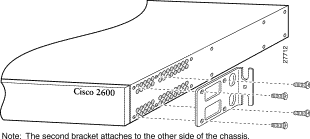
 |
Note When installed in a 19-inch rack with a 17.75-inch opening, the Cisco IAD1101 chassis will protrude beyond the front of the rack. |
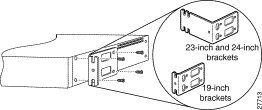


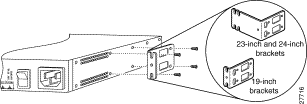
After the brackets are secured to the chassis, you can rack-mount it. Using screws that you provide, attach the chassis to the rack. (See Figure 3-7 and Figure 3-8).
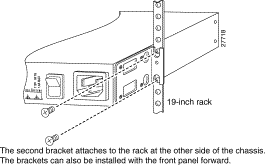
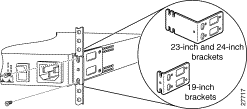
 |
Note Use 23-inch brackets (shown in Figure 3-1) to wall-mount the chassis. |
Take the following steps to wall-mount the chassis:
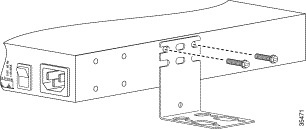
Step 2 Attach the chassis assembly to the wall as shown in Figure 3-10, using screws and anchors that you provide. We recommend the following:
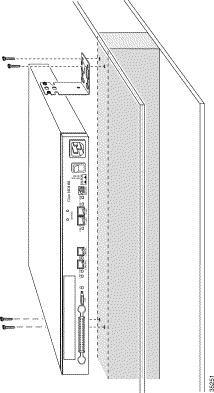
You must ground the Cisco IAD1101 chassis before connecting any network or subscriber cables. Attach the supplied grounding lug to the rear panel of the chassis, as shown in Figure 3-11. Connect the grounding lug to a grounded rack or other grounded metallic object, such as a grounding bar.
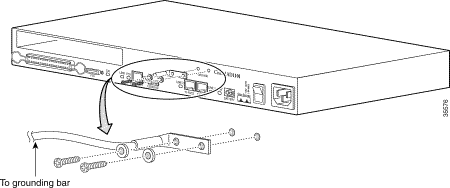
The Cisco IAD1101 accommodates one line interface module in the expansion slot (upper left on the rear panel). If your chassis does not have a pre-installed module in the expansion slot, follow this procedure to install a module.
 |
Caution To prevent electrostatic discharge damage to the Cisco IAD1101 chassis and components, you must wear an ESD-preventative strap when inserting or removing modules. Place the strap on your wrist, and connect the wire to an appropriate ground. |
To insert a line interface module:
Step 2 Carefully align the left and right edges of the module with the guides in the chassis.
Step 3 Gently slide the module into the slot until the lever (at the lower left of the module faceplate) touches the chassis. (See Figure 3-12.)

Step 4 Lift the lever up and slide the module into the slot until the module makes contact with the inside of the chassis.
Step 5 Secure the module by pressing the lever down. (See Figure 3-13.)
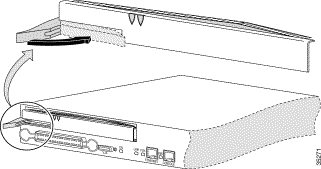
 |
Caution To prevent electrostatic discharge damage to the Cisco IAD1101 chassis and components, you must wear an ESD-preventative strap when inserting or removing modules. Place the strap on your wrist, and connect the wire to an appropriate ground. |
To remove a line interface module:
Step 2 Grasp the module faceplate, and carefully slide the module out of the slot.
Step 3 Place the module on an anti-static surface.
If your EMS workstation has a network interface card (NIC) or an Ethernet port, you can connect the workstation to the Ethernet port on the Cisco IAD1101 by using a RJ-45-to-RJ-45 rollover Ethernet cable. (See Figure 3-14.)
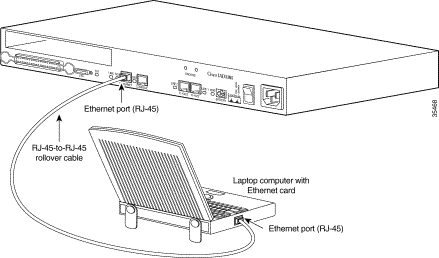
Your Cisco IAD1101 includes an EIA/TIA-232 interface that supports local administrative access to your Cisco IAD1101. Connect the workstation using the provided yellow Ethernet (straight) cable and the provided RJ-45-to-DB-9 adapter. (See Figure 3-15.)
 |
Note You must configure your workstation to use Dial-up Networking to access the Cisco IAD1101 through the console port. |

This section describes how to connect the Cisco IAD1101 to your network. The cables required to connect the chassis to a network are not provided. For ordering information, contact customer service (see the section "Cisco Connection Online" in the "About This Guide") or see the appendix "Connector and Cable Specifications" for cable and port pinouts.
 |
Warning Do not work on the system or connect or disconnect cables during periods of lightning activity. |
You can connect an Ethernet network to the Cisco IAD1101 by using a straight-through RJ-45-to-RJ-45 Ethernet cable. Connect the cable to the Ethernet connector on the Cisco IAD1101. (See Figure 3-16.)
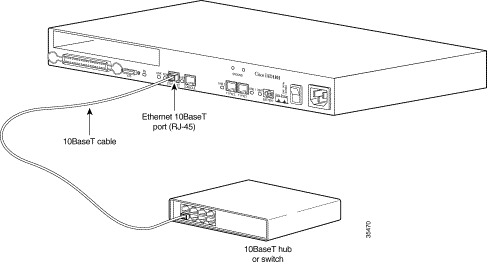
You can connect up to two T1 ports to the Cisco IAD1101 by using a straight-through RJ-48 to RJ-48 cable. Connect the cable to either T1 port on the Cisco IAD1101. (See Figure 3-17.)

You can connect up to 24 FXS circuits to the Cisco IAD1101 by using a 50-pin AMP-Champ cable from your analog subscriber equipment. Connect the cable to the analog connector on the Cisco IAD1101. (See Figure 3-18.)

You can connect an external router to the Cisco IAD1101 using an optional serial V.35 cable. Connect the cable to the V.35 port on the Cisco IAD1101. (See Figure 3-18.)
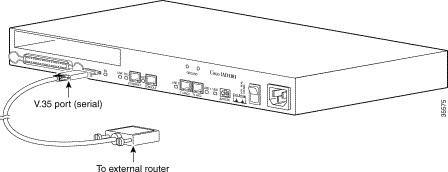
To connect and supply AC power to the chassis:
Step 2 Connect the other end of the power cord to the power outlet.
 |
Warning The plug-socket combination must be accessible at all times because it serves as the main disconnecting device. |
Step 3 Power ON the chassis.
The POWER LED should light immediately.
Step 4 The Cisco IAD1101 chassis begins an initialization process. The ACTIVE LED should light when the initialization is complete and the chassis is ready for provisioning.
The Cisco IAD1101 can be powered by an optional battery back-up box, providing -48V of DC power for a minimum of 8 hours.
 |
Warning To avoid short-circuiting the battery box, do not leave the battery cable next to a metal surface. Remove all metallic items, such as jewelry, before working with the battery box. |
You must have the following items to provide battery power to the Cisco IAD1101:
To connect and supply DC power from the battery box to the chassis:
Step 2 Connect the attached cable to the large connector on the adapter cable.
Step 3 Connect the small connector on the adapter cable to the battery connector on the Cisco IAD1101 chassis. (See Figure 3-20.)

Use the following procedures to power down the Cisco IAD1101:
To provision the Cisco IAD1101, consult the Cisco 6700 Series Element Management System User Guide, Software Release 1.4. See the "Obtaining Documentation" section to learn how to obtain user documentation.
![]()
![]()
![]()
![]()
![]()
![]()
![]()
![]()
Posted: Fri Oct 6 07:47:29 PDT 2000
Copyright 1989-2000©Cisco Systems Inc.